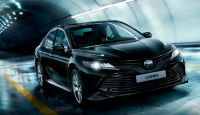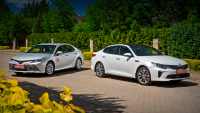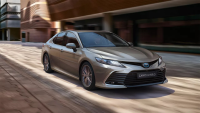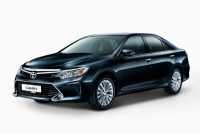Japanese cars have long and confidently conquered the world, firmly entrenched in the market. They are favorably distinguished by an adequate combination of price and quality, and repair of "Japanese" is more budget-friendly than their European counterparts.
From variety of Japanese firms, we offer to consider for comparison automobiles Toyota and Honda, in huge quantity meeting on roads.
A little about cars in general
Honda
This automaker does not boast a long history, although it goes back more than 80 years. In addition to cars, it produces highly popular motorcycles, airplanes, and is developing robotics.
According to the reviews of owners and evaluations of auto experts, Hondas belong to the number of reliable cars, which do not present any unpleasant surprises. It is believed that Honda equips its cars with the best engines in the world market and is a symbol of Japanese reliability.
 The suspension of the cars is multilever, almost eternal. Any model of the car can be made in any configuration and equipped with an engine according to possibilities, finances, and wishes. The cars look prestigious and that, in fact, is what they are.
The suspension of the cars is multilever, almost eternal. Any model of the car can be made in any configuration and equipped with an engine according to possibilities, finances, and wishes. The cars look prestigious and that, in fact, is what they are.
The most famous in this brand are the "sport-oriented" ones. In fact, these cars are not essentially racing cars, but have the best engine in its class compared to others, hence the passion to drive them. The engine volume does not exceed 2 liters, but due to special engineering, the power of the car increases significantly.
The disadvantages are the excessive cost of maintenance and "contrivance" of electronic brains, complicating repairs. Also noted the weakness of shock absorption - the bumps in the roads on the Honda is felt stronger.
Toyota
A well-known Japanese automobile company that has been on the market for 20 years longer than Honda. Since 2012, it has firmly held the leading position as the world's largest automaker. Throughout 2012-2015, it was listed as the most expensive car brand.
 They produce trucks, passenger cars and buses.
They produce trucks, passenger cars and buses.
The brand is famous for its conservatism, preferring to produce cars that do not differ in configuration and quality in different factories in different countries. Reliability is in the first place, and design extravagances recede into the background. In its own way, it is when with a minimum of frills, a small choice between a diesel and gasoline engine it offers accessible and inexpensive service with cheap accessories and spare parts.
Thus, the line Toyota allows choosing a car long and with taste - the lineup is rather wide. Here you can choose a small car and a truck, a convertible and a sedan, a cheap and expensive car equipped with a gasoline, diesel or hybrid engine.
Auto parts are easy to find, but they are often made in Chinese factories, and the quality is appropriate. Native Japanese parts have to be looked for.
What Honda and Toyota have in common
Honda and Toyota are two Japanese automakers that put reliability of their products at the top of their priorities.
The cars are quite "even" in operation, each has its own subtleties, but in general both brands are distinguished by their longevity and practicality in use. They last a long time, age beautifully, without becoming a pile of junk on wheels.
Despite the price difference, on average Honda is more expensive (including repairs), but its need for parts is much lower, and the lower price of Toyota is compensated by more frequent, though inexpensive repairs.
All Japanese products are about the same in quality. In the model range, each has its successes and shortcomings. Thus, the Toyota's C series (diesel) engines are almost trouble-free, and the same engine with a turbocharger 2C-T tends to malfunction.
If to speak about smoothness of a running gear and design features of a suspension, it is not necessary to dismiss a difference in steering. Honda has drivability of a sports car, its suspension by default should look stiffer, and Toyota is rather a sedate car, moving smoother and softer.
These are not advantages or disadvantages, this is the difference in purchasing demands of the drivers, who appreciate different speeds, have different driving habits and purchase cars for different purposes. The interior trim in general for the Japanese car industry in one class of cars is similar in quality. Therefore, it is better to compare particular models of one segment rather than all cars of the same manufacturer in one group.
Comparing Class D: Toyota Camry and Honda Accord
Both business class cars are designed for a relaxed ride for people who appreciate easy operation, spacious interior, predictable road behavior and reliability. They are popular and widespread in all countries.
We consider models with four-cylinder gasoline engines:
Camry has a 2.5-liter engine with 181 horsepower, automatic transmission with a 6-speed transmission; fuel consumption in the "city" mode is 11 liters per 100 kilometers, in "highway" mode - 5, 9 liters.
Accord is equipped with an engine 2.4 liter capacity of 180 hp, with a variator CME; fuel consumption in the "city" mode is 11.7 liters per 100 kilometers, in "highway" mode - 6.2 liters.
The difference:
The Camry loses to the Accord in looks, it's more rustic.
Accord consumes a little more fuel according to the "official version", but during test drives on the track Camry consumed more than its "opponent".
The Accord's new stepless variator is quiet, confident, and the best on the market today.
The Camry can switch to "manual" driving mode, allowing the driver to determine driving dynamics on his or her own.
On straightaways, the Accord has better dynamics and picks up speed faster.
The interior of the Camry looks more stylish and the finishing is of higher quality. But the Accord's interface is slightly more comfortable.
The Accord's front seats are more comfortable, there is more space in the back with the same size.
Conclusion: both cars are equally interesting, comfortable, even when traveling long distances. But despite the simpler appearance, in the Camry the driver feels a little bit better.


-rear-and-front-view-camera-6.png)

